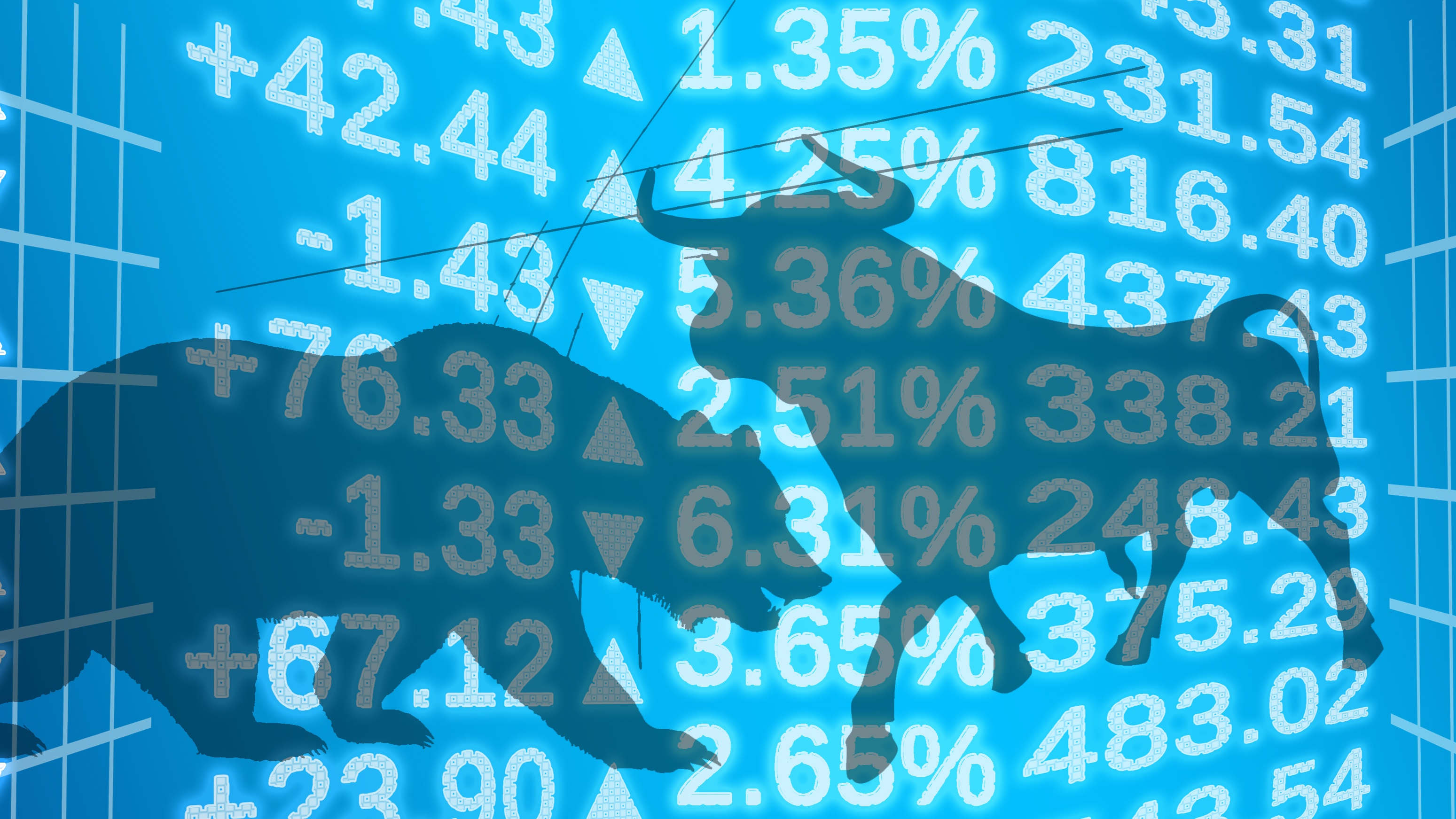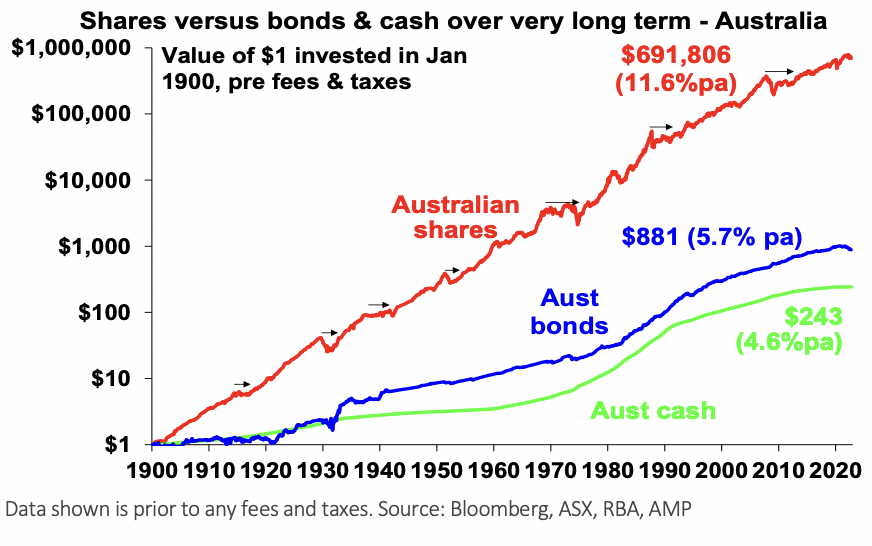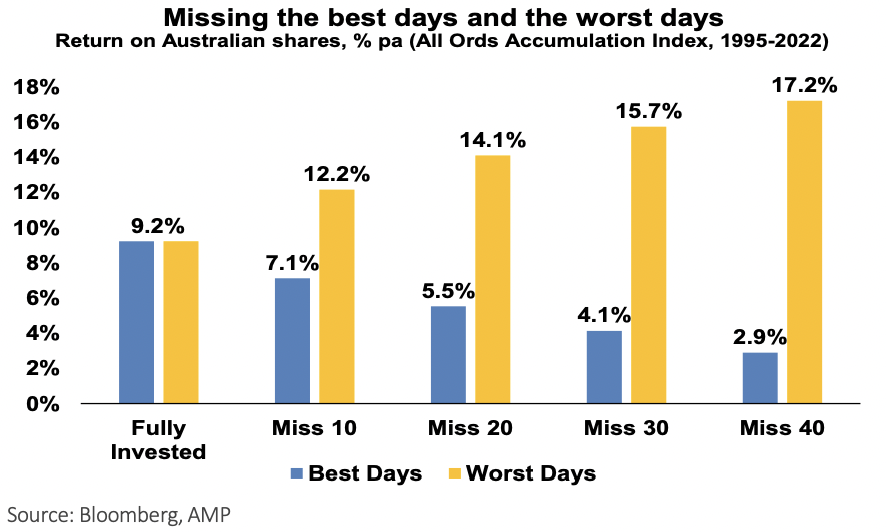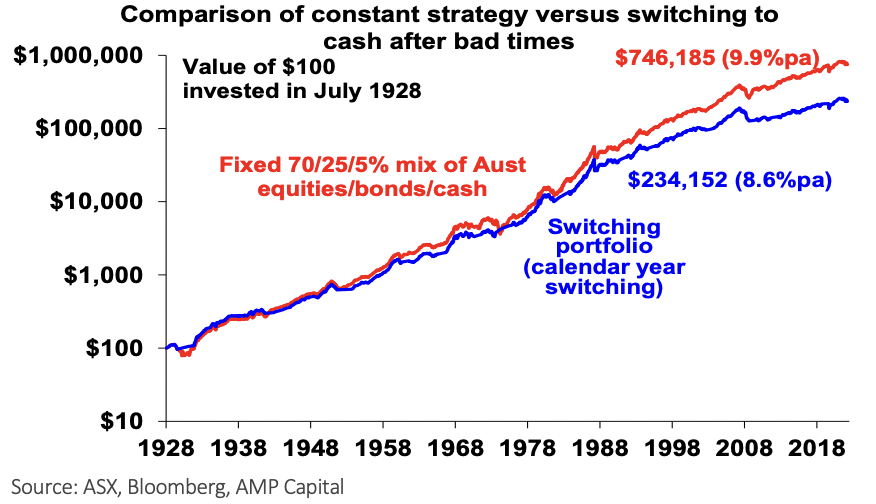Shane Oliver’s guide to riding out a "year to forget"
In January of this year, after bouncing around for a few months, the ASX200 took a sharp and sizeable leg down. It was to be the first of numerous heavy sell offs in what has been a year to forget for many investors.
At that time Dr Shane Oliver published an article on investor psychology and how to deal with the stresses of market falls. The article proved to be extremely popular, in fact, it is now the third ‘most-liked’ article on Livewire of all time.
I reached out to Shane to see if he could provide an update on the article given that volatility is still high and uncertainty around the market outlook remains. He kindly offered to refresh the article to reflect the current market dynamics and we agreed to sit down and talk through these views in more detail.

One of the things I enjoy about speaking with Shane is that he keeps things simple, is generally optimistic and he has a swag of great charts to help explain the important fundamentals of investing and markets.
The good news, according to Shane, is that we’re closer to the end of the RBA’s interest rate hiking cycle than the beginning. The resetting of official interest rates has been one of the key drivers of falls in most asset classes and led to bouts of high volatility. That process is concluding after an aggressive burst of hikes as the Reserve Bank found itself sharply behind the curve.
But Shane expects rate hikes to moderate from here and believes there is a chance we could see interest rate cuts towards the back end of 2023. He also expects Australian shares to deliver a positive return in 2023 (sigh of relief.)
The other piece of good news is that Shane believes Australia can plot a different course to many other economies. For example, he believes the chance of recession in Europe is 80% in the US it is a 50/50 call but in Australia the chance is only 40%.
Whilst Shane is generally upbeat on the outlook for 2023, he says it is important for investors to be mindful that we’re entering an extended period of higher inflation and that this has implications for investment strategy.
In the following interview we explore Shane’s views on the economic outlook, the implications for investment strategy, three essential charts to help investors stay the course and a glimpse into how Shane applies his knowledge to investing.
Topics discussed
- 0:00 – Introduction
- 1:29 – Where are we in the interest rate hiking cycle?
- 5:22 – Could the RBA cut interest rates in 2023?
- 5:55 – Can Australia avoid a recession in 2023?
- 8:43 – Do investors need a different strategy in 2023?
- 11:46 – Compounding – cash vs bonds vs equities (chart)
- 14:29 – Market timing and the impact of missing the best and worst days (chart)
- 15:33 – The cost of switching in and out of the market (chart)
- 17:11 – How Dr Shane Oliver invests
This transcript has been edited for length and clarity
Where are we in the current interest rate hiking cycle?
We're a long way through it, and I think we're closer to the end than the beginning. Markets move a lot faster than they used to. That's probably because of the more ready access to information these days and the speed with which that information flows to everyone. So, the adjustment occurs to new information a lot faster.
You think about the Ukraine war. Lots of bad news there, and it was horrible at the start. Markets reacted. Now people say, "Well, how come the market doesn't respond to the news on Ukraine much anymore?" Well, it's because it's already impounded into share prices.
It's the same with interest rate adjustments. I mean, horrible as it's been, markets were initially shocked when the Fed got more hawkish. Likewise, in Australia, that led to more downside, particularly those huge falls into June, and more recently in the case of the US with that more hawkish twist out of the Fed.
But the problem is there will come a time soon when we'll just get some slightly less worse inflation numbers out of the US. Maybe it will be the same in Australia, although I feel the US will lead on this one because I think we're about six months behind the US on inflation.
But mainly out of the US, you'll get a little bit less monthly inflation, and suddenly some of the commentary coming out of the Fed will be a little less hawkish. Some of it will still be hawkish, and markets will start to say, "Ah, we're almost there." Then before you know it, the Fed will start slowing down its hikes and come in close to the top.
So I reckon we're currently 3.25% for the Fed funds rate at the top end of their range. Yes, we've got some more upside there, probably up to around four and a half per cent.
Australia is different, though, and I know everyone on Twitter keeps telling me I'm crazy, the Aussie dollar's going to crash, and we'll all be ruined. But bear in mind that the household debt to income ratio in Australia is almost twice what it is in the US. 60% of mortgage holders in Australia have variable rates. So quick flow through from cash rate hikes to mortgage rates, two or three months before that shows up fully. And 40% on a fixed rate. But those fixed rates only go for 1, 2, or 3 years, and two-thirds of them have to roll over by the end of next year.
In the US, they're all sitting pretty. They've got 30-year fixed rates. 95% of loans in the US and 95% of 30-year loans are priced on the old rates. They got in two years ago at 3%, two and a half per cent, whatever it was. They're sitting pretty.
Of course, if the rate goes down again, they might think to refinance, which gave us part of the problem behind the GFC. But they're not going to refinance when they're sitting at 3%. Bad news for new borrowers as it is in Australia, but also in Australia, you get this quicker impact on existing borrowers.
So those two things, combined with the fact that we have wage growth in Australia, even if you get a bit pessimistic here and say it's not the 2.6% in the most recent official figures, it's 3.5%. You're talking about a number that is almost half what it is in the US. That will give the Reserve Bank a bit more flexibility, and I think they were right to slow down the pace of hikes at their October meeting.
We think we'll see some more hikes out of the RBA, probably again in the November meeting. Not so good for economists because it's Melbourne Cup Day. But after that, it's touch and go as to whether we're going to see anymore.
As we get to the start of next year, the Reserve Bank will say, well, the global economy's slowing down. That's going to have a negative impact on us. We're now seeing the lagged impact from the rate hikes we've put through on consumer spending, obviously already seeing housing, and therefore the cash rate will top out probably around 2.85%, but it could creep over that to 3.1%.
But I need to see it going up to the 4% the money market's talking about.
Will the RBA cut interest rates in 2023?
I reckon by the end of 2023, rates will be coming back down again. Not aggressively. It's probably going to be a slow process initially, but I think we're going to see a decline in inflation in Australia faster than the Reserve Bank is allowing for. So by the time we get to the end of the year, a combination of somewhat higher unemployment, probably not a recession, but somewhat higher unemployment and clear evidence inflation's coming down, will enable the Reserve Bank to start cutting.
The Australian market is only down ~8% over 12 months. Can Australia plot a different course to global markets such as the US?
It does feel like more in Australia because we have those bad days and billions wiped off, and that hits the headlines, and everyone thinks, "Oh, shock, horror, we've been ruined." But we've come down about 16% from the high in August to the low in June. If you look at it on a one-year basis, it's a lot less than that. We are above the lows in June, as I speak now. I mean, we always move around a bit, but we're above that. Whereas in the US, it's down 25%. Europe's down a bit more than that from the high. So, lots of markets have had far worse impacts.
I've come across lots of individual investors telling me their shares have crashed, and I'm thinking, well the market hasn't, 16% is not a crash, and we're above that. But it probably reflects some degree the outlook for the economy. It's less tenuous than in the US. I reckon it's almost certain that Europe will go into recession, I'd say 80%. On the US. It's not a certainty, but it's 50/50.
I'd say there's a 40% chance of recession here in Australia, and there are a few good reasons.
- A massive pipeline of work is yet to be done in the home-building industry.
- CapEx plans for businesses are pretty strong.
- The wages story in Australia is less strong than in other countries. Many people think that's a negative, but it's also positive because it means the Reserve Bank won't have to raise interest rates.
- The RBA won't have to hike as hard, so there less risk of overdoing it.
I think the Reserve Bank is a little bit more rational. Everyone wants to hate on the Reserve Bank these days, but they're trying to do the best they can. Obviously, they were caught out earlier this year, and they've caught up on that. But they're a bit more levelheaded than the Fed and some other central banks can be.
And they've already done a good job of telling us they're pretty certain about getting inflation back down to that two to 3%. But those things suggest to me they won't have to raise rates so much as to cause a recession.
And there are those sources of underlying strength in housing construction and CapEx spending, which will offset the weakness we will see in consumer spending, which hopefully means we're going to avoid a recession, although 40% chance we could still go there.
But it gives me a little more confidence that we're not going to see the 25% plus fall that US shares have had in Australia. And then, on a 12-month view, the Aussie share market will be up rather than down.
Do people need to change their strategy and how they're thinking about investing as we embark upon an era of higher interest rates?
Well, you do. We had a massive tailwind from about the time I started my career. Not because I started but the way of the world. You go back 40 years ago, and inflation had been very high. People got used to that very high inflation of the late seventies into the eighties. Bond yields double-digit. The old saying back then would be, you'd come to work, have a hunch, buy a bunch, go to lunch. Life's got a lot tougher. But to indicate how much easier it was, you could have bought 10-year bonds on 14%. The inflation rate back then was about eight and a half per cent. You're getting a massive real return. You just had to hold that thing for ten years and get your 14% plus your principal back. This is from the Australian government. It's not as easy now.
But anyway, as we went from those very high-interest rates, 14, 15%, as cash rate came down from a peak in 1989 of 18%, all those things went down to towards zero, cash rate 0.1%, bond yields 0.6%, a couple of years back.
That long-term downtrend provided a tailwind for investment markets. And the cash cry became, search for yield, chase for yields. TINA, there is no alternative. Go out there and search for good yield-paying stocks. And that provided a big tailwind for markets boosted returns. That provided a tailwind not just for shares, but for the property market, for example. That tailwind is probably behind us.
I don't think we will go back to near zero interest rates. Inflation will fall, but we're entering a world of somewhat higher inflation over the next decade than we had over the previous decade. And that means the strategy just based on chasing yield stocks could turn out to be a more risky strategy.
The other thing which complicates things is geopolitics, which messes things up in some ways. But that may be an okay thing for Australia because of the geopolitics, the increase in defence spending, and the decarbonization switch to net zero by 2050, all that stuff means more demand for metals.
So it's not necessarily the case that coal will do fantastically well after its huge run in the last couple of years. But at some point out there, there's going to be massive demand for metals, which I think probably does mean that Australian resources stocks still do pretty well. But recently, they've become in favour because of the yield characteristics. Going forward, that may be less of a factor back to more of a focus on their growth potential.
Please pick out some of your favourite charts from your analysis on the psychology of markets and share them with our viewers as to why staying the course is so important.
Well, the first one relates to the magic of compound interest. And I'm not the first to mention this. A guy who impacted me for many, many years throughout my career has been Dr Don Stammer. When I started, he was chief economist at Bain & Company. But he would always say, "You've got to make the most of the magic of compound interest and don't get blown off by the cycle." And the reason that's important is illustrated by a chart I had in that note, and it's my favourite chart.

It basically shows that if you invested $1 in 1900 and you reinvested any interest or if you put it in shares, any dividends along the way, so it's compound total return, that $1, believe it or not, would've grown today to be worth $243 in cash. Fantastic. $243 for $1. That's a return of 4.6%.
But if you'd put that money in Australian government bonds, that would've grown to about $881. Fantastic again, much better. Return of 5.7% per annum.
But the really big one is if you put it in shares, and this is where the magic of compounding kicks in. Returns growing on top of returns doesn't always work out. The year they canned the Brady Bunch, 1974, I got so depressed sold all my shares. Well, not really, but it was a horrible year for shares. You were thinking, whatever the compounding. Well if you'd been buying through that, you would've done fantastically well, same with the '87 crash, the GFC and so on. That $1 in 1900 through compounding, and this is total return, and I'm not taking account of people's tax, and with tax and fees, you can argue down, but you can also argue up with franking credits, so let's keep that to the side. That $1 as of the end of September would've grown to 691,806. Now that return on shares over that period, 120 odd years, is 11.6%, which is about double what you would've got on bonds.
But it's the compounding that really blows apart the difference. And that's the benefit of growth assets like shares or even property that you get that growth. And so if you're going to grow your wealth, you must stay the course with a growth asset. So the danger is trying to get your timing right. And a lot of people put a lot of effort into that, and they have some success, but a lot of people don't put the effort in. They're jumping around from this analyst to another one. They've got this system, that system, they get totally confused in the process.
And this old chart, which I love, I used to make fun of it when I was younger, and I thought it was just something financial planners love. But you can't ignore it, and it's basically called missing the best days and the worst days.

If you manage to get your timing right and you miss, say, the 40 worst days over the period since January 1995, compare how that would look to just staying the course and fully invested.
If you're fully invested from January 1995, again up until September, so it's monthly data, you would've had a total return of 9.2% per annum.
If you had a great timing model and you missed the worst 40 days, that return would've expanded to 17.2% per annum, almost double.
But if you get your timing wrong and you miss the 40 best days, that return drops to 2.9%.
So it just highlights how difficult it is to get the timing right. Slight slip, you could blow your potential return over the longer term.
And the third chart I like to bring your attention to compares the dangers of switching in terms of the actual impact on the portfolio. So what I've done here is compare two portfolios.

The first one is where you invest $100 way back in 1928 to give it a long time period. And you go into a constant mix of 70% Australian equities, 25% Australian bonds, and 5% Australian cash.
Now that $100 with compounding and reinvestment along the way would've grown to a portfolio of $746,000 in round terms today. And that's a return of about 9.9% per annum.
If, alternatively, you decided, well, after every year that I get a negative financial year return, I will switch to cash, and I only go back in once I have a positive financial year return. I've done that because it's usually after the falls that people go to cash, and it's usually after a good return year that people come back in again, and it's rare that they actually get the timing right at the bottom.
That portfolio starting at $100 back in 1928, would've grown to $234,000 in round terms, which is up, but it's only a return of 8.6%, 9.9% if you just stayed where you were. But the compounding is such that you end up with far less 234,000 versus $746,000.
So again, it highlights the dangers of switching. It does feel nice. You can sleep at night as the markets go down, but the odds are you're just going to lock in a loss and end up missing out on better longer-term returns.
Could you give us a bit of an insight into how you invest and the strategy you employ? Have you been using the weakness this year to add to your portfolio? What sort of asset class has been looking attractive to you?
I've got two buckets. I've got my superannuation and I've got non-superannuation stuff. In super, I'm using a mix of balanced funds on the platform that I have through my employer, and I've just kept on buying through that period as per the way superannuation works typically, and it's the balanced growth options. So yes, it's had a rough ride, but I'm confident that it will go back up again as the markets eventually recover.
For my non-super, I tend to have a mix of Australian shares and global shares. A very growthy bias in there. Initially, I was feeling, we could go through a bit of a pullback here; I'll let some cash build up. I've been thinking that now's the time to start averaging in, and that's how I do it. And then, I've got to make a conscious decision to start that averaging process.
Is the cash build-up from a regular contribution rather than selling?
There are two ways that the cash builds up. The main way it's built up in my case is simply that I've saved from my income, and then you get bonuses from employer earlier in the year. So I've let that build up, thinking, well, this will be a good time to average into the market. So that's the way I tend to do it.
I don't consider myself a big stock picker. I've done that over the years, but I tend to focus more on things like ETFs and index funds as an easier way. But there are better ways for others to do it. It's up to you.
3 topics
1 contributor mentioned


